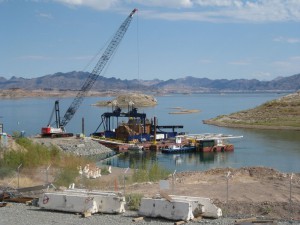Update: The papers are all on line here, and seem to be freely available.
It stands as a cliché in western water circles to say that John Wesley Powell was right. But yeah, he pretty much was.
“Powell’s conclusion in 1876,” John Sabo and his colleagues write this week in the Proceedings of the National Academy of Sciences, “was that water scarcity would place limits on the growth of a new civilization in the region.”

Construction site of the Southern Nevada Water Authority's new Lake Mead intake, being built so Las Vegas can still get water as the reservoir drops. Taken October 2010
The Sabo piece is part of a fascinating package of PNAS papers organized by Glen MacDonald from UCLA assembling the latest science on water, climate and the arid west.
It’s an incredible array, touching on the paleo record, ecosystem issues, water supply questions, attribution of current drought and projection of future conditions. I’ve got a short piece trying to hit a few high points in tomorrow’s newspaper, but it was an absolutely maddening journalistic exercise because the range assembled by MacDonald is so topic rich.
I’d like to take some more time and space here to explore the package in more detail over the next however many days this takes, starting with the most clever paper of the bunch, by a team led by Sabo from Arizona State University: Reclaiming freshwater sustainability in the Cadillac Desert (Note: as of this writing, the papers don’t seem to be up on the PNAS site, though the embargo is off. As that changes, I’ll come back and add links.)
Sabo and his colleagues use Marc Reisner’s journalistic portrait of a “region-wide hydrologic dysfunction” in his classic Cadillac Desert as their starting point, and crunch the numbers to see how the argument holds up 26 years after the book’s publication.
It’s a fitting starting point for the discussion, because of the central role of Cadillac Desert in western discourse over water. Sabo et al. look at three core arguments made by Reisner:
- That reservoir siltation dooms the hydraulic engineering structures we’ve built in the West.
- That salt buildup in agricultural soil dooms agriculture.
- That we face an inevitable struggle between agriculture and cities over increasingly scarce water supplies.
Sabo and his colleagues use a clever approach to the problem of understanding the unique characteristics of western water problems by comparing western watersheds and water management systems to those in the eastern United States, using the 100th meridian as a dividing line.
While they authors conclude that Reisner’s fears of siltation were overstated, on the other two grounds they find that Cadillac Desert’s basic thesis holds up to a 21st-century empirical analysis.
On siltation:
[A]lthough Reisner was correct that reservoirs fill with sediment, observed infilling and complete loss of storage function … will not likely occur for most large reservoirs in the foreseeable future.
On salt buildup:
Both the accumulation of salt and the extent of salt-affected soils are more prevalent in the West. Total estimated revenue losses experienced by the agricultural sector are ?2.8 billion US dollars (USD) annually. Estimated revenue losses are nearly an order of magnitude higher in the West (2.55 billion USD per year, West vs. 267 million USD per year, East). Crop yields and revenue have been disproportionately affected in western watersheds, particularly in regions with extensive areas of vegetable crops and orchards. Revenue losses are ?60-fold higher per acre of cropland in the West.
On competition between water for cities and water for food:
[T]he capacity for water to support cities, industry, agriculture, and ecosystems in the US West is near its limit under current management practices. For an urban population double the Census 2000 size, we estimate that water withdrawals necessary to meet municipal, industrial, and agricultural demand will exceed 86% of the current streamflow across parts of seven hydrologic regions in the southwest United States.
Real sustainability requires withdrawals of more like 60 percent of streamflow, the authors argue, which would require:
a regional water conservation policy coordinated across seven US states addressing at a minimum: (i) continued improvements in urban water use efficiency, (ii) implementation of desalinization by coastal cities, (iii) continued improvements in land-use practices that minimize erosion and sediment infilling of the region’s reservoirs, (iv) technological advances increasing water application efficiency during irrigation, (v) modified crop portfolios that include only salt tolerant and cash crops, (vi) effective reallocation of salvaged surface water to ecosystems as farmlands are retired and cities shift to desalinization, and (vii) endorsement of market-based rather than government subsidized water pricing for all uses except those that fulfill the most basic daily human needs.

Adapting to the realities that Reisner and JW Powell would have us recognize requires us to simultaneously hold the concepts of hydrologic commons and private property. We consistently perceive them as being in diametric opposition: “fish vs. farmers”, “jobs vs. environment” are destructive myths. The fact is that “water’s for cooperatin’ over.”